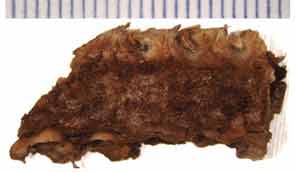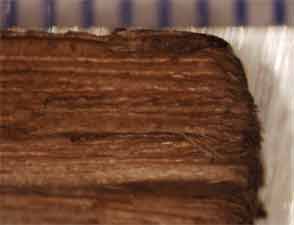At times, visual microscopy can perform the forensic evaluation required to identify the particle or particles. At other times, tools such as a portable X-ray fluorescence unit can perform the required chemical analysis. A skilled analyst using these and other tools can determine the root cause of the defect and identify the origin of the foreign body.
The following case studies illustrate how a materials laboratory can be useful in determining corrective measures to create a zero-defect situation for safe food handling and processing.
Despite the industry’s best efforts, the presence of foreign particles and matter in food products is inevitable. This problem is controlled when all engineering approaches and proper mechanical designs have been properly employed.



Loose Metallic Shards in Meat Processing
- Case study No. 1 – metallic debris found in processed beef jerky product. This piece of metallic debris was found within a quarantined piece of a beef jerky product. In-stream magnetic detection systems successfully isolated this sample from a consumer product at the processing plant. Laboratory analysis of the debris was able to identify the material to find a root cause. It was determined that a failing meat grinding refining plate used in the processing stream was misaligned, allowing metal shards to enter the food product pool.
- Case study No. 2 – metallic debris found in a ground beef processing lot. Inspectors found a metal fragment within a rejected lot of ground beef at the processing plant. A materials testing lab analyzed the shard and determined it came from high-carbon steel typical of a cutting blade. The lab achieved the analysis using EDS, which is well-suited for small samples like this 3-mm specimen. Further investigation determined the cutting blade was excessively brittle and identified the cause as inadequate heat treatment of the cutting blade.
- Case study No. 3 – nonmetallic matter found in a batch of deli salad. An unidentified nonmetallic chunk was found in a popular deli salad product, which led to a personal injury claim. Laboratory testing identified the debris as an organic contaminant that most closely resembled a vegetable waste—a portion of a corncob normally removed during processing. It was also determined that this corncob remnant had been softened in brine solution during processing and was unlikely to have caused the dental damage in this case. This lab-created section of a corncob was used to help identify key features of the nonmetallic matter found in the commercial deli salad product. The food processors took corrective measures by adding in-stream detection systems to identify and react to foreign material when present, and the process has not experienced a problem since implementation.
- Case study No. 4 – novelty glassware with heavy metal paint contamination. These popular promotional items were found to contain high levels of a restricted heavy metal. Lab testing was performed using portable X-ray fluorescence, which discovered the presence of cadmium on the outer surfaces. Cadmium was further identified as an unwanted component of the ink used to print the colorful images. The EPA, FDA, and other governing bodies carefully limit toxic metals levels in all consumer products. These restrictions also cover consumer toy products, which are carefully monitored for the presence of other elements, including lead, mercury, cadmium, and chromium. Though not a food product, it is a container of consumable liquids. The issue is germane to processing, because there are times when items in the food manufacturing cycle are in contact with painted or plated surfaces. The above-mentioned lab techniques, specifically XRF, were used for the detection of unwanted chemicals or heavy metals in this case.
- Case study No. 5 – wood sample in snack product potato chip processing plant. An unidentified foreign matter was segregated using an air blast separator employing visual inspection techniques during final product packaging. Quality control required identification of all foreign matter found during processing. Because it was covered in product residue, the entire sample required analysis. Laboratory testing identified the debris as an organic contaminant most closely resembling wood. This recovered section of a wood material was suspected to have come from a material-handling palette. Based on the testing and analysis of the manufacturer’s process, the operation determined that the episode was unique to this batch, and no further procedural changes were necessary.
Controlling the Unavoidable
Despite the food processing industry’s best efforts, the presence of foreign particles and matter in food products is inevitable. This problem is controlled when all engineering approaches and proper mechanical designs have been properly employed. With that said, and in the spirit of continuous improvement, it is imperative that containment and root cause of system failures be quickly identified, especially when considering that the processor’s reputation is at stake.
ACCESS THE FULL VERSION OF THIS ARTICLE
To view this article and gain unlimited access to premium content on the FQ&S website, register for your FREE account. Build your profile and create a personalized experience today! Sign up is easy!
GET STARTED
Already have an account? LOGIN
